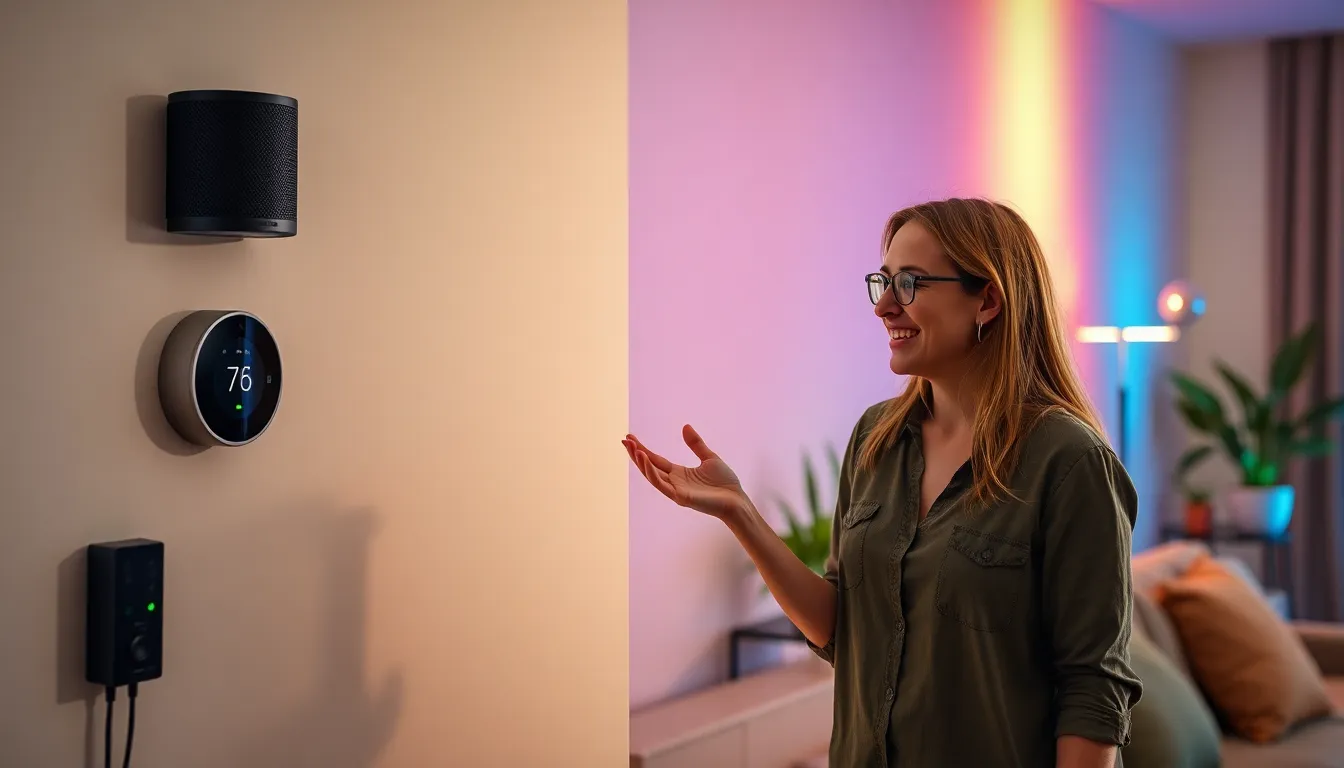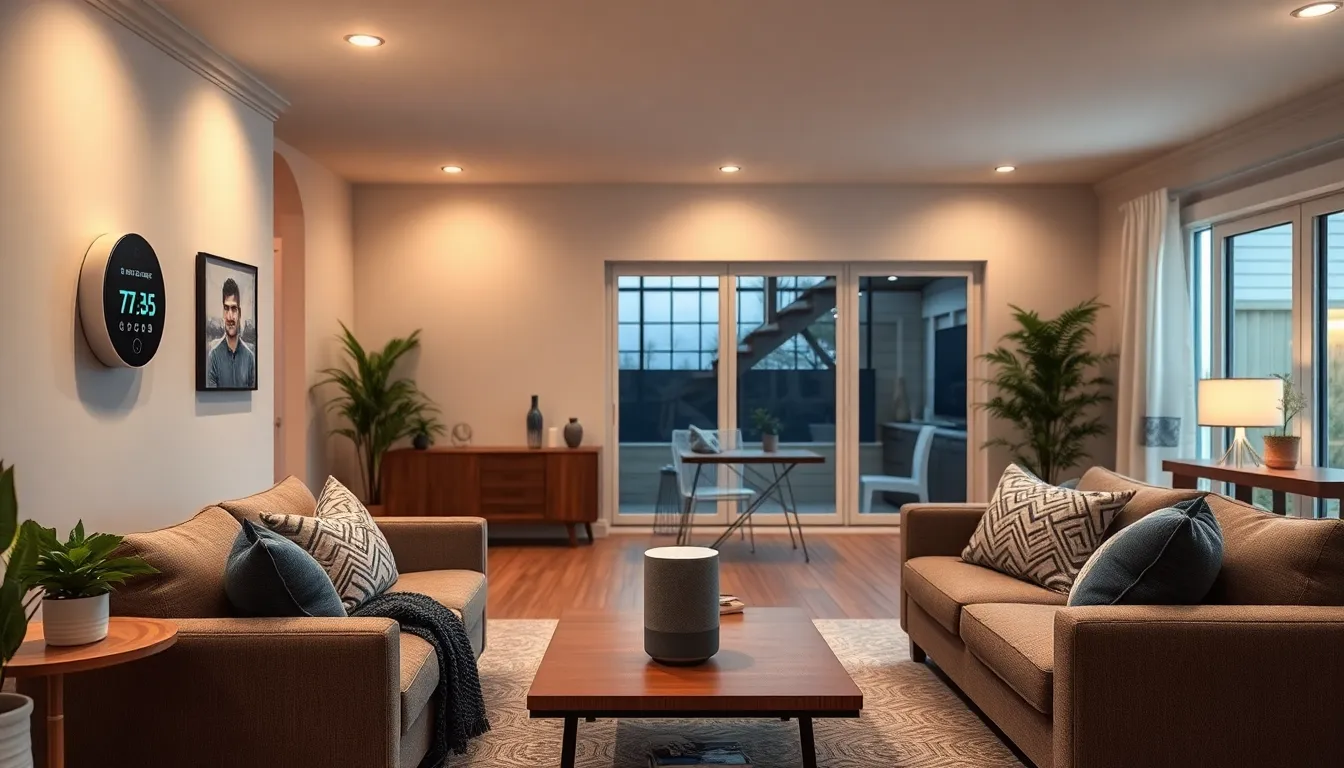Table of Contents
ToggleImagine walking into your home and having it greet you like an old friend. Smart home devices do just that, turning everyday living into an experience that’s both convenient and a bit futuristic. From voice-activated assistants that know your coffee order better than your barista to security systems that keep an eye on your castle while you’re away, these gadgets are changing the way people live.
But it’s not just about convenience; smart devices can save time, energy, and even a few bucks on your utility bill. Who wouldn’t want a home that anticipates their needs, like a butler who’s had a little too much caffeine? Dive into the world of smart home technology and discover how these devices can elevate your lifestyle, making your home not just smarter, but also a whole lot cooler.
Overview of Smart Home Devices
Smart home devices revolutionize daily routines through automation and connectivity. Home automation gadgets like smart thermostats adjust temperatures according to preferences, enhancing comfort and energy efficiency. Voice-activated assistants, such as Amazon Echo and Google Nest, enable hands-free control of various devices, increasing convenience in household management.
Security systems equipped with cameras and motion sensors provide real-time monitoring, ensuring peace of mind. For example, smart locks allow remote access management, simplifying entry for family and friends. Additionally, smart lighting solutions can be programmed to create specific atmospheres, promoting relaxation during evenings.
Energy-saving devices also play a crucial role in modern homes. Smart plugs help monitor energy usage, assisting homeowners in reducing electricity costs. Water-saving devices, such as smart irrigation systems, optimize water usage for gardens and lawns, supporting sustainability efforts.
Smart appliances, including refrigerators and washing machines, enhance efficiency and convenience by offering remote operation features. These appliances streamline meal prep and laundry tasks, providing more time for leisure activities. Integration with home networks creates seamless communication between devices, enabling enhanced control.
Moreover, user-friendly apps allow for centralized management of multiple smart devices. Many platforms support customization, ensuring that each device functions according to individual preferences and routines. As smart home technology continues to advance, it transforms ordinary living spaces into interconnected environments, fostering improved quality of life.
Benefits of Smart Home Devices
Smart home devices offer numerous advantages that significantly enhance everyday living. Users can experience increased convenience, enhanced security, and improved energy efficiency.
Increased Convenience
Automation simplifies daily routines. Smart devices, such as thermostats and lighting systems, allow users to control their environment remotely. Voice-activated assistants make managing tasks effortless, enabling hands-free interactions. Scheduling capabilities mean routines can adjust automatically, ensuring optimal comfort at all times. As a result, users enjoy more leisure time and less stress from daily management.
Enhanced Security
Smart home devices improve security through advanced monitoring features. Security cameras provide real-time video feeds, allowing homeowners to keep an eye on properties, regardless of location. Motion sensors alert users to any unusual activities, increasing safety awareness. Remote access to smart locks enables secure entry for family and friends, offering peace of mind. Integration with alarm systems ensures immediate notifications during emergencies, reinforcing overall home security.
Energy Efficiency
Energy-saving capabilities stand out among smart home devices. Smart thermostats optimize heating and cooling operations, reducing waste and lowering utility costs. Devices like smart plugs allow users to monitor energy consumption and schedule usage patterns. Irrigation systems adjust water use according to weather conditions, promoting efficient resource management. Overall, these features contribute to significant energy savings while supporting sustainability initiatives.
Popular Types of Smart Home Devices
Smart home devices come in various types, each designed to enhance convenience, security, and energy efficiency in homes. Below are some popular categories that many homeowners find beneficial.
Smart Lighting
Smart lighting systems allow users to manage light settings through apps or voice commands. These devices often include features like dimming, color adjustments, and scheduling. Energy savings result from LED technology and the ability to turn off lights remotely. Integration with other smart home systems ensures seamless operation, creating a welcoming atmosphere for any occasion. Popular brands like Philips Hue and LIFX provide diverse options tailored to user preferences.
Smart Thermostats
Smart thermostats adapt to user behaviors, optimizing heating and cooling schedules for comfort and energy savings. Some models learn preferences over time, adjusting settings automatically. Features like remote access enable users to control temperatures from anywhere, ensuring efficiency and cost savings on energy bills. Models like the Nest Learning Thermostat and Ecobee SmartThermostat offer compatibility with various HVAC systems. Data tracking highlights usage patterns, providing insights that enhance energy management.
Smart Security Systems
Smart security systems protect homes through real-time monitoring and alerts. These systems include cameras, motion detectors, and smart locks, all accessible via smartphones. Users can receive notifications for any suspicious activity and remotely control entry points. Brands like Ring and Arlo offer comprehensive solutions that enable home monitoring from anywhere. Advanced features such as facial recognition and cloud storage improve security and provide peace of mind for homeowners.
Considerations for Choosing Smart Home Devices
Selecting the right smart home devices involves multiple factors that can influence overall satisfaction and usability.
Compatibility with Existing Systems
Compatibility plays a crucial role when choosing smart home devices. Many devices must seamlessly integrate with current systems, ensuring fluid operation within households. Consider platforms like Amazon Alexa or Google Assistant, as they provide wider compatibility with various brands. When searching for smart devices, check specifications for interoperability. Prioritizing compatibility increases user experience, allowing multiple gadgets to work together harmoniously.
Ease of Use
Ease of use significantly impacts the enjoyment of smart home technology. Devices should feature intuitive interfaces, making installation and operation simple for all users. A user-friendly app enhances control, enabling adjustments from smartphones or tablets. Explore voice control options; such capabilities often improve accessibility. Assess whether devices provide comprehensive guides or tutorials to support users. Selecting easy-to-use products promotes engagement and satisfaction with smart home systems.
Cost and Budget
Cost considerations influence purchasing decisions for smart home devices. Setting a budget upfront helps filter options according to financial feasibility. Evaluate the initial investment alongside long-term savings; some devices may reduce energy bills over time. Look for financing plans or bundle offers that add value without overextending finances. Research different brands and read reviews; informed decisions often yield favorable outcomes. Investing in quality devices ensures reliability and enhances overall home automation experiences.
Conclusion
Smart home devices are reshaping the way people live by enhancing convenience and security while promoting energy efficiency. As technology continues to evolve these gadgets become more integrated into daily routines making life easier and more enjoyable.
With options ranging from smart lighting to advanced security systems homeowners can customize their environments to suit their needs. The ability to control devices remotely not only saves time but also offers peace of mind.
Investing in smart technology isn’t just about modernizing a home; it’s about creating a sustainable lifestyle that prioritizes efficiency and comfort. As more individuals embrace these innovations the future of home living looks brighter and more connected than ever.





